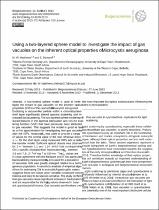 ResearchSpace
ResearchSpace
Using a two-layered sphere model to investigate the impact of gas vacuoles on the inherent optical properties of Microcystis aeruginosa
JavaScript is disabled for your browser. Some features of this site may not work without it.
- ResearchSpace
- →
- Research Publications/Outputs
- →
- Journal Articles
- →
- View Item
| dc.contributor.author |
Matthews, MW

|
|
| dc.contributor.author |
Bernard, Stewart

|
|
| dc.date.accessioned | 2014-06-17T10:28:38Z | |
| dc.date.available | 2014-06-17T10:28:38Z | |
| dc.date.issued | 2013 | |
| dc.identifier.citation | Matthews, M.W. and Bernard, S. 2013. Using a two-layered sphere model to investigate the impact of gas vacuoles on the inherent optical properties of Microcystis aeruginosa. Biogeosciences, vol. 10, pp 8139-8157 | en_US |
| dc.identifier.issn | 1726-4170 | |
| dc.identifier.uri | http://www.biogeosciences.net/10/8139/2013/bg-10-8139-2013.html | |
| dc.identifier.uri | http://hdl.handle.net/10204/7461 | |
| dc.description | Copyright: 2013 European Geosciences Union (EGU). This is an Open Access journal. The journal authorizes the publication of the information herewith contained. Published in Biogeosciences, vol. 10, pp 8139-8157 | en_US |
| dc.description.abstract | A two-layered sphere model is used to investigate the impact of gas vacuoles on the inherent optical properties (IOPs) of the cyanophyte Microcystis aeruginosa. Enclosing a vacuole-like particle within a chromatoplasm shell layer significantly altered spectral scattering and increased backscattering. The two-layered sphere model reproduced features in the spectral attenuation and volume scattering function (VSF) that have previously been attributed to gas vacuoles. This suggests the model is good at least as a first approximation for investigating how gas vacuoles alter the IOPs. Measured R(subrs) was used to provide a range of values for the central value of the real refractive index, 1 + e, for the shell layer using measured IOPs and a radiative transfer model. Sufficient optical closure was obtained for 1 + e between 1.1 and 1.14, which had corresponding Chl a-specific phytoplankton backscattering, b(subbf)*, between 3.9 and 7.2 × 10-3 m2 mg-1 at 510 nm. The b(subbf)* values are in close agreement with the literature and in situ particulate backscattering measurements. R(subrs) simulated for a population of vacuolate cells was greatly enlarged relative to a homogeneous population. A sensitivity analysis of empirical algorithms for estimating Chl a in eutrophic/hypertrophic waters suggests these are robust under variable constituent concentrations and likely to be species-sensitive. The study confirms that gas vacuoles cause significant increase in backscattering and are responsible for the high Rrs values observed in buoyant cyanobacterial blooms. Gas vacuoles are therefore one of the most important bio-optical substructures influencing the IOPs in phytoplankton. | en_US |
| dc.language.iso | en | en_US |
| dc.publisher | European Geosciences Union (EGU) | en_US |
| dc.relation.ispartofseries | Workflow;12735 | |
| dc.subject | Microcystis aeruginosa | en_US |
| dc.subject | Phytoplankton | en_US |
| dc.subject | Optical properties | en_US |
| dc.subject | IOPs | en_US |
| dc.subject | Cyanophyte Microcystis aeruginosa | en_US |
| dc.title | Using a two-layered sphere model to investigate the impact of gas vacuoles on the inherent optical properties of Microcystis aeruginosa | en_US |
| dc.type | Article | en_US |
| dc.identifier.apacitation | Matthews, M., & Bernard, S. (2013). Using a two-layered sphere model to investigate the impact of gas vacuoles on the inherent optical properties of Microcystis aeruginosa. http://hdl.handle.net/10204/7461 | en_ZA |
| dc.identifier.chicagocitation | Matthews, MW, and Stewart Bernard "Using a two-layered sphere model to investigate the impact of gas vacuoles on the inherent optical properties of Microcystis aeruginosa." (2013) http://hdl.handle.net/10204/7461 | en_ZA |
| dc.identifier.vancouvercitation | Matthews M, Bernard S. Using a two-layered sphere model to investigate the impact of gas vacuoles on the inherent optical properties of Microcystis aeruginosa. 2013; http://hdl.handle.net/10204/7461. | en_ZA |
| dc.identifier.ris | TY - Article AU - Matthews, MW AU - Bernard, Stewart AB - A two-layered sphere model is used to investigate the impact of gas vacuoles on the inherent optical properties (IOPs) of the cyanophyte Microcystis aeruginosa. Enclosing a vacuole-like particle within a chromatoplasm shell layer significantly altered spectral scattering and increased backscattering. The two-layered sphere model reproduced features in the spectral attenuation and volume scattering function (VSF) that have previously been attributed to gas vacuoles. This suggests the model is good at least as a first approximation for investigating how gas vacuoles alter the IOPs. Measured R(subrs) was used to provide a range of values for the central value of the real refractive index, 1 + e, for the shell layer using measured IOPs and a radiative transfer model. Sufficient optical closure was obtained for 1 + e between 1.1 and 1.14, which had corresponding Chl a-specific phytoplankton backscattering, b(subbf)*, between 3.9 and 7.2 × 10-3 m2 mg-1 at 510 nm. The b(subbf)* values are in close agreement with the literature and in situ particulate backscattering measurements. R(subrs) simulated for a population of vacuolate cells was greatly enlarged relative to a homogeneous population. A sensitivity analysis of empirical algorithms for estimating Chl a in eutrophic/hypertrophic waters suggests these are robust under variable constituent concentrations and likely to be species-sensitive. The study confirms that gas vacuoles cause significant increase in backscattering and are responsible for the high Rrs values observed in buoyant cyanobacterial blooms. Gas vacuoles are therefore one of the most important bio-optical substructures influencing the IOPs in phytoplankton. DA - 2013 DB - ResearchSpace DP - CSIR KW - Microcystis aeruginosa KW - Phytoplankton KW - Optical properties KW - IOPs KW - Cyanophyte Microcystis aeruginosa LK - https://researchspace.csir.co.za PY - 2013 SM - 1726-4170 T1 - Using a two-layered sphere model to investigate the impact of gas vacuoles on the inherent optical properties of Microcystis aeruginosa TI - Using a two-layered sphere model to investigate the impact of gas vacuoles on the inherent optical properties of Microcystis aeruginosa UR - http://hdl.handle.net/10204/7461 ER - | en_ZA |





